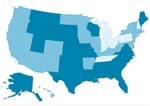government
Medicare pay reprieve in place; next threat is 2% cut in March
■ The SGR patch, paid for by cuts to hospitals, some specialists and others, doesn't address long-term payment stability or looming Medicare sequestration reductions.
- WITH THIS STORY:
- » How Congress paid for the SGR patch
Washington After another year-end nail-biter on Capitol Hill in which lawmakers made preventing a massive Medicare physician pay cut their last action before adjourning, organized medicine called on Congress to chart a more rational course on the issue in 2013.
Late on Jan. 1, the House voted in favor of a legislative package approved by the Senate in the early hours of the morning that postponed a 26.5% cut to doctors' pay rates mandated by the sustainable growth rate formula, clearing the way for President Obama's signature on Jan. 2. Although enactment technically came after the cut officially had taken effect, the result of the retroactive measure is that all 2013 physician claims will be paid at 2012 levels. The House vote on the package was 257-167, and the Senate vote was 89-8.
Organized medicine groups, including the American Medical Association, hailed the passage of the latest SGR patch but reiterated their strong belief that Congress must approve a permanent solution that avoids the recurring year-end drama that ensues from leaving the temporary measure until the eleventh hour. The latest stopgap freezes doctor pay rates only through the end of 2013, after which the formula again will slash rates by about a quarter without a new legislative revision.
“This last-minute action on the part of Congress is a clear example of how the Medicare program is increasingly unreliable for physicians and patients,” said AMA President Jeremy A. Lazarus, MD. “This instability stalls progress in moving Medicare toward new health care delivery models that can improve value for patients through better care coordination. Physicians want to work with Congress to move past this ongoing crisis and toward a Medicare program that ensures access to care and the best health outcomes for patients, and a stable, rewarding practice environment for physicians.”
David L. Bronson, MD, president of the American College of Physicians, said it was regrettable that Congress did not pursue a more lasting solution to the chronic problem of the physician pay formula.
“In the short term, this legislation helps ensure access to high-quality medical care for Medicare beneficiaries, and ensures that physician payments under Medicare will not be cut through 2013,” Dr. Bronson said. “However, a greater bipartisan effort is still needed in the coming year to approve legislation that permanently repeals once and for all the flawed SGR formula, and transitions to payment models that provide predictable annual updates to physicians participating in Medicare, while being aligned with the provision of high-quality and efficient care.”
Medicare sequester cut still looms
The SGR patch was included in a broader legislative tax and spending package designed to address major elements of what lawmakers and others have referred to as the fiscal cliff. The measure extends some tax cuts for many Americans and postpones a series of automatic federal defense and nondefense spending reductions known as sequestration.
Medicare physician pay rates and many other federal expenditures would be affected by the sequester, the consequence of Congress and the Obama administration failing to agree on more targeted spending cuts during 2011 negotiations. If such an agreement or another delay cannot be achieved by March 1, the new sequestration deadline established by the departing 112th Congress, doctor pay will be reduced by 2% under the automatic cuts. Certain non-Medicare health programs, such as clinical research and health professions funding, will be cut by 7.8% for 2013.
“The sequestration's 2% cut in Medicare physician payment undercuts the positive impact of the 12-month patch to the sustainable growth rate,” said Glen Stream, MD, the American Academy of Family Physicians board chair. “Such a cut perpetuates the cycle of instability that elderly and disabled Americans have suffered for more than 10 years.”
Dr. Stream added that the higher sequester cut on health professions grants would endanger the ability of the primary care work force to meet future patient demand.
Even if the 113th Congress forges an agreement with the White House over alternative spending reductions to the across-the-board cuts, federal health programs are likely to shoulder a significant portion of the load. Medicaid spending, as well as Medicare benefits and eligibility, cannot be touched by sequestration, but lawmakers are under no such restrictions when crafting an alternative plan.
Obama acknowledged Medicare as a major driver of the national debt in remarks after House approval of the fiscal cliff package.
“I agree with Democrats and Republicans that the aging population and the rising cost of health care makes Medicare the biggest contributor to our deficit,” Obama said on Jan. 1 after the House vote. “I believe we've got to find ways to reform that program without hurting seniors who count on it to survive. And I believe that there's further unnecessary spending in government that we can eliminate.”
Deep partisan disagreements over allowing tax rates to rise on higher-income earners nearly torpedoed the entire Jan. 1 package, including the Medicare pay freeze. Congressional observers predicted another bruising fight over spending in the months leading up to the new sequestration deadline.
“The bill sets Congress and the White House up to revisit these battles and a major deficit reduction effort in two months,” said Eric Zimmerman, a partner in the Washington office of McDermott Will & Emery. “Sometime between now and March 1, 2013, Congress and the White House will need to come to agreement on how to reapportion sequestration, fund the federal government for the balance of [fiscal] 2013 and raise the debt ceiling, and Medicare and Medicaid spending will feature prominently in those debates.”
Hospital, dialysis, imaging pay take hits
The passage of the latest physician payment patch only delays the SGR cut by a year, but the move did not come without a significant cost. Other areas of Medicare, some of which might impact doctors' pay directly, were subjected to cuts to help pay for the temporary solution. The $25.2 billion cost of freezing Medicare doctor pay rates at 2012 levels — as well as the roughly $4 billion cost of extending certain expiring Medicare and other health payment provisions — was paid for in large part by reducing payments to hospitals, dialysis providers and Medicare private plans.
Hospital organizations expressed disappointment at being hit with cuts that were used as offsets for the across-the-board physician pay freeze and Medicare extensions. One offset involves changing the inpatient prospective payment system to reduce hospital payments by $10.5 billion.
“It is not in the best interest of patients or those who care for them to rob hospital Peter to pay for fiscal cliff Paul,” said Chip Kahn, the Federation of American Hospitals president and CEO. “These cuts could impact hospital services for those who need them the most.”
In addition, revisions in the way Medicare calculates the expected use of certain drugs when bundling payments for end-stage renal disease treatment providers also will result in $4.9 billion in pay reductions that the ACP's Dr. Bronson noted will affect compensation for physicians providing care to kidney disease patients.
The American College of Radiology blasted Congress for approving an offset provision that will reduce payments for certain advanced imaging services by $800 million to help pay for the SGR patch.
“Reverting to continuous provider cuts to help pay for a morbidly flawed payment policy, in an environment that resembles more 'Alice in Wonderland' than 'Mr. Smith Goes to Washington,' is an embarrassment to our country and a disservice to our nation's seniors,” said Paul Ellenbogen, MD, chair of the ACR Board of Chancellors. “These cuts will ultimately damage patient access to medical imaging care and may drive up long-term costs by delaying diagnosis of illness and disease to later stages where more expansive, and expensive, treatments are required.”
Dr. Bronson noted, however, that lawmakers did not pursue some ideas for savings that were floated during budget negotiations, such as rescinding a health system reform law provision that raises Medicaid rates for primary care physicians to Medicare levels in 2013 and 2014. Congress also steered clear of cuts to graduate medical education as well as evaluation and management changes that would have reduced hospital pay further.












